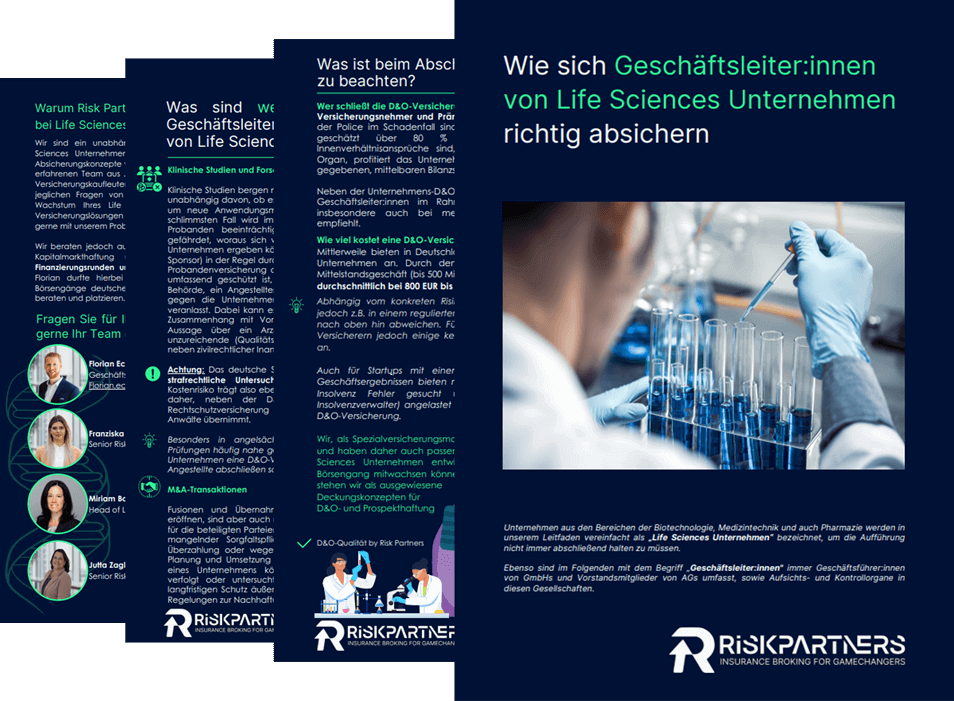Risk Partners Life Sciences Roundtable 2025, thank you very much!
Risk Partners Life Sciences Roundtable 2025, thank you very much!
How to insure clinical studies with radioactive substances or ionizing radiation
Clinical trials are necessary in order to test non-approved drugs or new medical devices. In our series on relevant insurance cover for clinical trials, following Part 1 "Insurance for test subjects" and Part 2 "Travel accident insurance", we would now like to turn to "radiation liability insurance" This is taken out with an AMG or MPG-approved special liability insurer - usually with the help of a special insurance broker like us as your risk partner.
Radiation liability insurance is required by the Federal Office for Radiation Protection (BfS) as part of a separate approval or notification procedure for clinical studies in which the use of radioactive substances or ionizing radiation on humans is intended in accordance with the Radiation Protection Act (StrlSchG) or the X-ray Ordinance (RöV).
The insurance cover applies if a claim is made against the sponsor / CRO on the basis of statutory liability provisions under private law due to damage that resulted in the death, injury or damage to the health of the volunteer or patient.
Due to frequent downstream damage, a long follow-up reporting period (at least 10 years) must be ensured.
The clinical trial insurance does not cover damage to the health of volunteers/patients if it occurs within the clinical study as a result of the study-related use of radioactive substances or ionizing radiation on humans for the purpose of medical research. As one of many points, this requires separate approval from the Federal Office for Radiation Protection (BfS).
Nevertheless, it makes sense - especially if the volunteer insurance is mandatory - to coordinate these two types of cover. As the test persons/patients already receive a certain amount of cover for damage to health through test person insurance, radiation liability insurance should only offer additional insurance cover. This is referred to as supplementary radiation liability insurance, which is economically superior to full radiation liability insurance.
From a risk management perspective, it is essential to create a common risk awareness in the first step, which is largely supported by the risk strategy. Convince your investors in the due diligence process of your next financing round with a risk report and a deep understanding of your risks, thereby safeguarding against risks that could threaten your company's existence.
On the basis of sound risk and insurance management, we develop a decision-making basis for your company. You decide what to insure and what not to insure. Because not every risk is worth insuring. Here is our basic approach:
Your added value through active risk and insurance management:
The importance of this for young growth companies was demonstrated not least by the Silicon Valley Bank case, which was identified as part of a risk management process and - if necessary - would have led to an adjustment of the banking/treasury strategy.
(1) Anyone who uses radioactive substances or ionizing radiation on human beings for the purpose of medical research shall require approval, unless the use of radioactive substances or ionizing radiation on human beings for the purpose of medical research is subject to notification pursuant to Section 32 (1). Approval is also required for anyone who deviates significantly from an application approved in accordance with this provision.
(2) The application for approval shall be accompanied by the documents required for examination.
(3) The competent authority shall check the documents required for the examination for completeness within 21 calendar days of receipt of the application for approval. If the documents are incomplete, the competent authority shall request the applicant to rectify the deficiencies it has identified within 21 calendar days of receipt of the request. The competent authority shall decide on the application for approval within 90 calendar days of receipt of the complete application documents. The competent authority may extend the deadline by 90 calendar days if this is necessary due to the difficulty of the examination. The extension of the deadline must be justified and communicated in good time. The permit shall be deemed to have been granted if the competent authority has not made a decision on the permit application within the extended period.
(4) The competent authority may only grant approval if
(5) The provision for the fulfillment of statutory compensation obligations within the meaning of paragraph 4 number 7 shall be made for the period from the beginning of the application until the expiry of ten years after the end of the research project. Paragraph 4 number 7 shall not apply insofar as the requirements of the Nuclear Insurance Cover Ordinance are fulfilled in terms of reason and amount by the provision made to meet statutory compensation obligations in accordance with the corresponding provisions of the Medicinal Products Act or the Medical Devices Implementation Act.
(6) If the application provides for the use of radioactive substances or ionizing radiation in several facilities (multi-centre study), the competent authority shall grant a comprehensive authorisation for all facilities for which the requirements pursuant to paragraph 4 numbers 6 and 8 are fulfilled.
1) In the approval procedure, the administrative authority shall determine the type, scope and amount of the provision for the fulfillment of statutory compensation obligations (cover provision) to be made by the applicant. The determination shall be made every two years and again in the event of a significant change in circumstances; in doing so, the administrative authority shall set a reasonable deadline for the party obliged to provide cover, within which the cover must be proven.
(3) Within the framework set out in paragraph 2 and in order to achieve the purposes set out in section 1, more detailed provisions may be issued by statutory order on the measures required to provide for the fulfillment of statutory compensation obligations. In this context, the amount of the financial security shall be regulated within the framework of a maximum limit of EUR 2.5 billion; the maximum limit and the amounts of cover shall be reviewed every five years with the aim of maintaining the real value of the financial security.
(4) The Federal Government and the Länder shall not be obliged to provide cover; this shall apply mutatis mutandis to the third party pursuant to Section 9a (3) sentence 2, second half-sentence. Insofar as a Land is liable under the Paris Convention in conjunction with section 25 (1) to (4), under section 25a or under one of the international treaties referred to in section 25a (2), the licensing authority shall determine, applying subsections (1) and (2) and the statutory order issued under subsection (3) mutatis mutandis, to what extent and in what amount the Land shall be liable for the fulfillment of statutory compensation obligations without coverage by the indemnification obligation under section 34. This obligation to assume liability shall be equivalent to the provision of cover when applying this Act. Sentences 2 and 3 shall not apply to the Federal Government.
Good Clinical Practice (GCP) is an internationally recognized ethical and scientific standard for the planning, conduct, documentation and reporting of human clinical trials. Compliance with this standard creates public confidence that the rights, safety and welfare of the subject will be protected in accordance with the principles set out in the Declaration of Helsinki. Measures must also be taken in the event of harm to the trial participant as a result of the clinical trial. This is ensured by taking out the right insurance and by providing additional health care.
"Together with our subsidiary "Atrialis GmbH - experts in clinical trial insurance", we are one of the market-leading specialists and can provide you with competent support in the risk structuring and transfer of complex international studies as well as in the event of a radiation liability insurance claim thanks to our many years of experience."
Jutta Zaglauer - Senior Risk Advisor Life Sciences

Team Risk Partners is currently compiling examples from our customer base on the costs of radiation liability insurance and supplementary radiation liability insurance for you.
# | Small study | Medium study | Large international study |
|---|---|---|---|
1. | X-Y EUR | X-Y EUR | X-Y EUR |
Request our guides now


Everything you need to know to optimally protect you and your life sciences / biotech company.